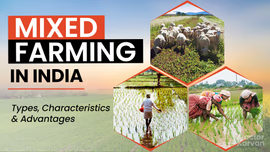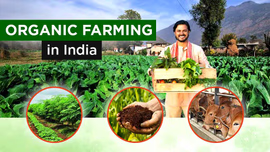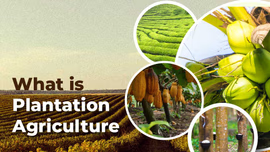Mango Farming in India: Step-by-Step Cultivation Process

You must have eaten mangoes so many times, right? It is the favourite fruit crop in India for a majority of the population. It is considered as the “King of Fruits”. However, the question that comes to mind is: What is the cultivation process of mangoes? For that, we have got you covered! In today’s blog, we will explore the process of planting mango in India along with its varieties, benefits, and value-added products. So, without any further delay, let’s quickly begin with the blog.
Table of Contents
- An Overview of Mango Farming in India
- Popular Varieties of Mango in India
- Step-by-Step Process of Mango Cultivation
- Mango Production in India
- India Facts and Figures in Mango Cultivation
- Value-Added Products of Mango
An Overview of Mango Farming in India
Mango belongs to the Family Anacardiaceae, and its scientific name is Mangifera indica. As we know, mango is the king of fruits due to its delicious taste, excellent flavour and attractive fragrance. It is also rich in vitamins A and C. It is also rich in antioxidants. The cultivation of mango was originated in S.E. Asia. India has the richest collection of mango cultivars. Though mangoes are considered low maintenance and hardy fruit crop but the grafts used in commercial mango farming, needs proper care and maintenance. This pulpy and juicy fruit comes in many varieties in India. Now, let’s have a look at the popular mango varieties available in India below.
Popular Varieties of Mango in India

In India, about 1500 varieties of mango are grown, including 1000 commercial varieties. Some of the most popular mango varieties are given below:
- Alphonso
- Banganapalli
- Dashehari
- Kesar
- Langra
- Mankurad
- Bangalora
- Chausa
- Himsagar
- Safeda
Step-by-Step Process of Mango Cultivation
Soil and Climate
Mango can grow on almost all types of soils, but the red loamy soil is quite ideal for mango plants. Rich, medium and well-drained soils give much better results. Mangoes prefer slightly acidic soils from pH 5.5 to pH 7.5. In India, mangoes are grown in both tropical and subtropical conditions. Mango cultivation requires good rainfall and a dry summer. The ideal temperature is a temperature between 22°C – 27°C. Heavy winds and cyclones cause flower and fruit shedding and breaking of branches.
Land Preparation
The field preparation is the most important step in the cultivation of mangoes. Deep ploughing followed by harrowing and levelling with a gentle slope for good drainage is required for land preparation. A pit of 1 x 1 x 1 m is ideal. Fill in with topsoil mixed with 10 kg of FYM and 100 g Lindane 1.3% dust per pit.
Planting
The planting of mangoes is usually done in the month of July-August in rainfed areas and during February-March in irrigated areas. In heavy rainfall zones, planting is done at the end of the rainy season. Mango can be propagated from seed or grafts. The spacing pattern should be 10 x 10 m in the dry zones where growth is less, to 12 x 12 m in heavy rainfall areas and rich soils where enough vegetative growth occurs.
Training and Pruning
Usually, frequent pruning is not required for mango plants. However, proper training should be done to get the plant in good shape. It is important, especially when the branches are placed at very low levels. The main branches should be at least 20-25 cm apart. It should be spaced in a way that both the branches should be grown in opposite directions.
Irrigation Management
The amount of irrigation provided to the crop depends upon the type of soil, climatic conditions, rainfall, and the distribution and age of the tree. In adult trees, irrigation at 10 to 15 days intervals from fruit to maturity is required to obtain good yield. Before 2-3 months of flowering, irrigation is not advisable as it leads to vegetative growth at the expense of flowering. Basin irrigation and drip irrigation are recommended for better yield.
Intercropping
Intercropping should be done when the mango plant reaches a suitable height and develops a canopy. It should be 5-6 years old. Green gram, mustard, sesame, groundnut, cabbage, cauliflower, tomato, potato, brinjal, cucumber and chillies can be grown as intercrops. Pineapple, ginger, turmeric, etc., are partial shade-loving crops that can also be cultivated in grown orchards. Moreover, inter-fillers like papaya, guava, peach, plum, etc. can also be grown as they don’t interfere with the main mango plant.
Fertilizer Application
In general, 170 gm urea, 110 gm single super phosphate and 115 gm muriate of potash per plant per year of the age from first to tenth year and thereafter, 1.7 kg, 1.1 kg, and 1.15 kg respectively of these fertilisers per plant per year can be applied in two equal split doses (June-July and October). A foliar spray of 3% urea is recommended before flowering in sandy areas.
Pest and Disease Management
|
Pest and Diseases |
Symptoms |
Control |
|
Mango Hopper |
Shedding of flower buds and flowers |
Spray two rounds of acephate 75 SP@ 1g/lit or phosalone 35 EC@ 1.5 ml/li
|
|
Mango Stem Borer |
Grub tunnels in the sapwood on the trunk or branches |
One celphos tablet (3 g aluminium phosphide) per hole |
|
Fruit Fly |
Maggot bore into semi-ripen fruits with decayed spots and dropping of fruits. |
Carbaryl 50 WP 4 g/l. two rounds at 2 weeks interval before ripening of fruits. |
|
Powdery Mildew |
White superficial powdery fungal growth on leaves, stalks of panicles, flowers and young fruits. |
Two to three sprays of wettable sulphur (0.2%) or Kerathane (0.1%) at 10-15 days interval. |
Harvesting and Yield
The mango plant starts bearing fruits from the 6th year onwards. However, the grafted plants start bearing at the age of 3-4 years (10-20 fruits) to give optimum crop from 10-15th years, which continues to increase up to the age of 40 years under good management. The yield depends on the variety, climatic conditions, plant population, etc. The average yield ranges from 5 to 9 tonnes/acre.
Mango Production in India
India leads in the area and production of mango. Mango accounts for 39% of the area under fruit crops in India. India ranks first in mango production, accounting for about 50% of the world’s mango production. Other major mango-producing countries are China, Thailand, Mexico, and Pakistan. India produced more than 20 metric tonnes of mangoes in 2022-23. The major mango-producing states as per APEDA in 2021-22 in India are given below:
|
State |
Production (thousand tonnes) |
Share (%) |
|
Uttar Pradesh |
4,807.83 |
23.64 |
|
Andhra Pradesh |
4,676.06 |
22.99 |
|
Karnataka |
1,745.57 |
8.58 |
|
Bihar |
1,549.97 |
7.62 |
|
Telangana |
1,157.73 |
5.69 |
India Facts and Figures in Mango Cultivation
- According to APEDA, Uttar Pradesh ranks first in mango production with a share of 25.76% and the highest productivity in 2023-24.
- India is one of the major exporters of mangoes in the world. The country has exported 32,104.09 Metric Tonnes of fresh mangoes to the world for the worth of INR 495.46 crores during the year 2023-24.
- In 2023-24, the major export countries are the United Arab Emirates, the UK, the USA, Kuwait, and Qatar.
Value-Added Products of Mango

In India, mango is abundantly available from March to mid-August. It is used in both its raw and ripe stages. At the peak of its season, mango is produced in large quantities in India, so it can be preserved in different forms using various methods. Mango value-added products are also available in the Indian market. Value-added product processing reduces post-harvest loss and increases farmers’ income. It helps in off-season availability, generates employment opportunities, balances nutrients, and increases export trade and foreign exchange. Some value-added products of mango are listed below:
- Mango Chutney
- Mango Pickle
- Mango (Aam) Papad
- Mango Juice
- Mango Squash
- Mango (Amchur) Powder
- Mango Jam
- Mango Fruit Bar
- Mango (Aam) Panna
The production of new products from mango waste has also started, such as flour from mango waste kernel, starch or fat from the kernel, pectin from mango peel, and many other by-products of mango. Compared to other fruits, mangoes have more by-products, so proper cultivation and ripening practices, harvesting handling and improved transport facilities are needed to generate more income for livelihood.
Frequently Asked Questions On Mango farming in India
1. Is mango farming profitable in India?
With a large number of mangoes produced and a higher yield annually, mango farming is very profitable for Indian farmers.
2. Which state is the largest producer of mango in India?
Uttar Pradesh is the largest mango producer in India.
3. Which soil is best for mango trees?
Mango can be grown in almost all types of soils. However, the red loamy soil is the ideal soil for mango trees.
4. What is the lifespan of a mango tree?
Mango trees can live up to more than 100 years.
5. What is the best time to plant a mango tree?
The best time for planting mangoes is usually in the months of July to August in rainfed areas and during February to March in irrigated areas.
6. How many types of mangoes are there in India?
The different types of mangoes in India are Alphonso, Dashehari, Langra, Chausa, Himsagar and Safeda.


Related Blogs












